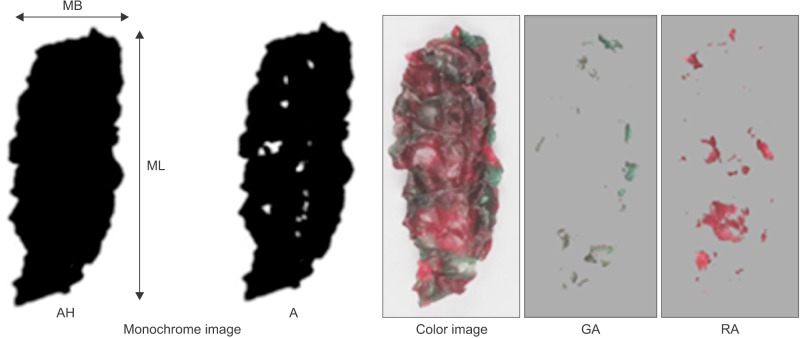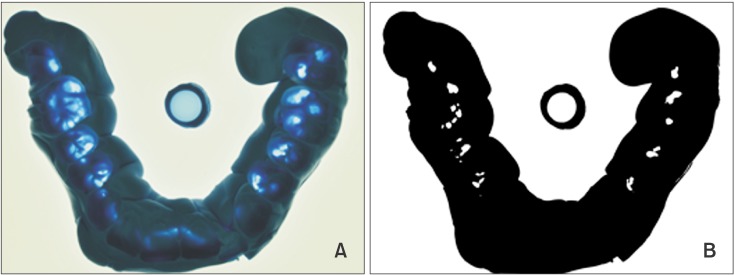1. Buschang PH. Masticatory ability and performance: the effects of mutilated and maloccluded dentitions. Semin Orthod. 2006; 12:92–101.

2. Miura H, Miura K, Mizugai H, Arai Y, Umenai T, Isogai E. Chewing ability and quality of life among the elderly residing in a rural community in Japan. J Oral Rehabil. 2000; 27:731–734. PMID:
10931271.

3. Christiansen EG. The chewing power of teeth. Br Dent J. 1924; 45:318–319.
4. Mahmood WA, Watson CJ, Ogden AR, Hawkins RV. Use of image analysis in determining masticatory efficiency in patients presenting for immediate dentures. Int J Prosthodont. 1992; 5:359–366. PMID:
1520458.
5. Sato H, Fueki K, Sueda S, Sato S, Shiozaki T, Kato M, et al. A new and simple method for evaluating masticatory function using newly developed artificial test food. J Oral Rehabil. 2003; 30:68–73. PMID:
12485386.

6. Schimmel M, Christou P, Herrmann F, Müller F. A two-colour chewing gum test for masticatory efficiency: development of different assessment methods. J Oral Rehabil. 2007; 34:671–678. PMID:
17716266.

7. Horie T, Kanazawa M, Komagamine Y, Hama Y, Minakuchi S. Association between near occlusal contact areas and mixing ability. J Oral Rehabil. 2014; 41:829–835. PMID:
25155067.

8. Henrikson T, Ekberg EC, Nilner M. Masticatory efficiency and ability in relation to occlusion and mandibular dysfunction in girls. Int J Prosthodont. 1998; 11:125–132. PMID:
9709601.
9. Tate GS, Throckmorton GS, Ellis E 3rd, Sinn DP. Masticatory performance, muscle activity, and occlusal force in preorthognathic surgery patients. J Oral Maxillofac Surg. 1994; 52:476–481. discussion 482. PMID:
8169710.

10. Wilding RJ. The association between chewing efficiency and occlusal contact area in man. Arch Oral Biol. 1993; 38:589–596. PMID:
8368956.

11. Hatch JP, Shinkai RS, Sakai S, Rugh JD, Paunovich ED. Determinants of masticatory performance in dentate adults. Arch Oral Biol. 2001; 46:641–648. PMID:
11369319.

12. Okiyama S, Ikebe K, Nokubi T. Association between masticatory performance and maximal occlusal force in young men. J Oral Rehabil. 2003; 30:278–282. PMID:
12588500.

13. Toro A, Buschang PH, Throckmorton G, Roldán S. Masticatory performance in children and adolescents with Class I and II malocclusions. Eur J Orthod. 2006; 28:112–119. PMID:
16272209.

14. English JD, Buschang PH, Throckmorton GS. Does malocclusion affect masticatory performance? Angle Orthod. 2002; 72:21–27. PMID:
11843269.
15. Iwase M, Ohashi M, Tachibana H, Toyoshima T, Nagumo M. Bite force, occlusal contact area and masticatory efficiency before and after orthognathic surgical correction of mandibular prognathism. Int J Oral Maxillofac Surg. 2006; 35:1102–1107. PMID:
17097270.

16. Choi YJ, Lim H, Chung CJ, Park KH, Kim KH. Two-year follow-up of changes in bite force and occlusal contact area after intraoral vertical ramus osteotomy with and without Le Fort I osteotomy. Int J Oral Maxillofac Surg. 2014; 43:742–747. PMID:
24630069.

17. Katz MI. Angle classification revisited. 1: Is current use reliable? Am J Orthod Dentofacial Orthop. 1992; 102:173–179. PMID:
1342781.

18. Lee H, Kim M, Chun YS. Comparison of occlusal contact areas of class I and class II molar relationships at finishing using three-dimensional digital models. Korean J Orthod. 2015; 45:113–120. PMID:
26023539.

19. Kim KH, Choy KC, Kim HG, Park KH. Cephalometric norms of the hard tissues of Korean for orthognathic surgery. J Korean Assoc Oral Maxillofac Surg. 2001; 27:221–230.
20. Carlsson GE. Masticatory efficiency: the effect of age, the loss of teeth and prosthetic rehabilitation. Int Dent J. 1984; 34:93–97. PMID:
6376372.
21. Ackerman JL, Proffit WR. The characteristics of malocclusion: a modern approach to classification and diagnosis. Am J Orthod. 1969; 56:443–454. PMID:
5261158.
22. Koshino H, Hirai T, Ishijima T, Ikeda Y. Tongue motor skills and masticatory performance in adult dentates, elderly dentates, and complete denture wearers. J Prosthet Dent. 1997; 77:147–152. PMID:
9051602.

23. van den Braber W, van der Glas HW, van der Bilt A, Bosman F. Chewing efficiency of pre-orthognathic surgery patients: selection and breakage of food particles. Eur J Oral Sci. 2001; 109:306–311. PMID:
11695750.

24. Zhou Y, Fu M. [Masticatory efficiency in skeletal class III malocclusion]. Zhonghua Kou Qiang Yi Xue Za Zhi. 1995; 30:72–74. 127Chinese. PMID:
7648921.
25. Julien KC, Buschang PH, Throckmorton GS, Dechow PC. Normal masticatory performance in young adults and children. Arch Oral Biol. 1996; 41:69–75. PMID:
8833593.

26. Owens S, Buschang PH, Throckmorton GS, Palmer L, English J. Masticatory performance and areas of occlusal contact and near contact in subjects with normal occlusion and malocclusion. Am J Orthod Dentofacial Orthop. 2002; 121:602–609. PMID:
12080313.

27. Yoon HR, Choi YJ, Kim KH, Chung CR. Comparisons of occlusal force according to occlusal relationship, skeletal pattern, age and gender in Koreans. Korean J Orthod. 2010; 40:304–313.

28. Ando K, Kurosawa M, Fuwa Y, Kondo T, Goto S. A study on measuring occlusal contact area using silicone impression materials: an application of this method to the bite force measurement system using the pressure-sensitive sheet. Dent Mater J. 2007; 26:898–905. PMID:
18203497.

29. Magalhães IB, Pereira LJ, Marques LS, Gameiro GH. The influence of malocclusion on masticatory performance. A systematic review. Angle Orthod. 2010; 80:981–987. PMID:
20578873.





 PDF
PDF ePub
ePub Citation
Citation Print
Print






 XML Download
XML Download